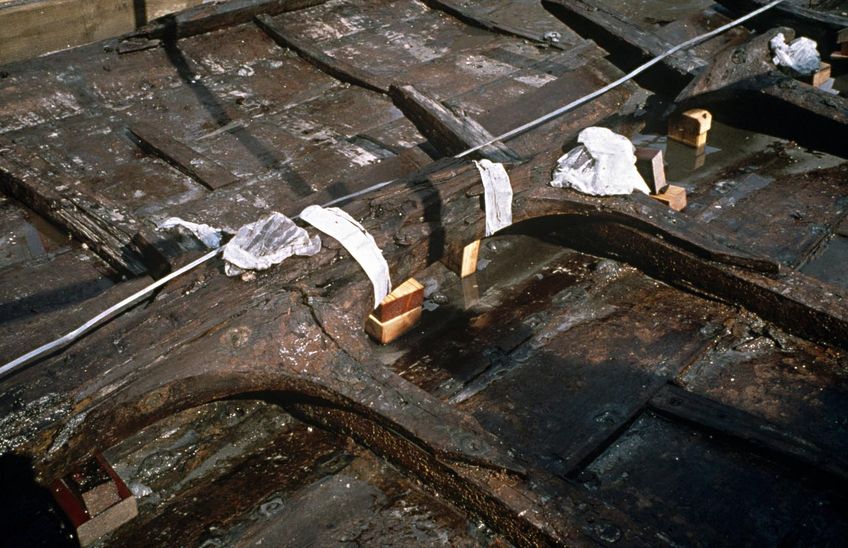Roskilde 6
Roskilde 6 was found – together with eight other ships from Viking times and the Middle Ages – during the construction of the Museum Harbour for the Viking Ship Museum in 1997. The ship had been hauled up into shallow water in Roskilde's Viking harbour area and partially broken up. Therefore, only part of the bottom was preserved. Despite this it is one of the most remarkable Viking ship finds yet seen.
The feature that makes the most immediate impression, is the length of the ship. The keel is almost intact and measures 32 m. Adding on the stem and stern gives a total length for the whole ship approaching 36 m – the longest Viking ship yet discovered. The distance between the ribs is about 80 cm, allowing the approximate number of oarsmen to be calculated. There were probably 39 pairs of oars and, accordingly, 78 oarsmen to serve them. A ship of this size was without doubt the property of a king or earl and probably one we are acquainted with from written sources. The age of the ship has not yet been established exactly. The preliminary results of the dendrochronological studies only show us that the ship was built after AD 1025.
It is not only the size of Roskilde 6, which is remarkable. Its great length forced the shipbuilders to adopt unusual measures and solutions. As a consequence, the 32 m long keel is made up of three sections. The use of keel extensions, loter, is not in itself unusual, but the way in which the central keel section and the extensions are joined together is. In Viking ships it was normal to use simple vertical through-scarfs or hooked scarfs to join the keel and the loter together.
These were simple to make, but counteracted only to a limited extent up and down movements of the stem and stern in the waves. These scarfs are less than three times as long as the keel is wide at the joint. In Roskilde 6, the joints between the central keel section and the 4 m long loter are almost 2 m long and are ingeniously shaped to have a bracing effect in both a vertical and a horizontal plane.
The intention was clearly to make the whole of the long keel behave, as far as possible, as a single piece of timber. Perhaps it gives us an indication of where the shipbuilders had to focus their attention and improve their construction methods as the warships of the Late Viking Age were built progressively longer and longer. It is therefore striking that the surviving lot from the longship in Hedeby Harbour contributed in practice just as much to the length of the ship, i.e. rather more than 2m, as the loter from Roskilde 6 – but in the Hedeby ship it was possible to suffice with a vertical hooked scarf of only 25 cm.
Part of the explanation could be, however, that the two ships were built for different sailing conditions. Hedeby 1 was an extremely narrow vessel, whereas Roskilde 6's width has provisionally been reconstructed at about 3.7 m. Even so, it was still built narrower than the Irish-built Skuldelev 2.

The ship was built with great care and with carefully selected materials. This can be seen, for example, in the up to 8 m long oak planks which were used for the ship’s hull, but also in the elegant form of the ship’s internal components. The keelson was held in place by carefully carved double knees, which were spiked partly to the sides of the keelson and partly to the upper surface of the floor timbers. Between the ribs lie thin, shaped and fitted intermediate frames, which bound together the otherwise vulnerable transition between bottom and side. This is a typical longship feature which can also be seen on Hedeby 1 and Skuldelev 2, but conversely not on the smaller vessels such as Ladby and Skuldelev 5.
Archaeological findings of longships
Learn more about the longships we know today. Some were found in burial mounds, others in the Viking's harbours and others were recycled by the Vikings as part of defense systems of their main towns.
Below you can find links to read more about the longships.
» Ladby - the ship in the grave
» The longship from Haithabu Harbour
